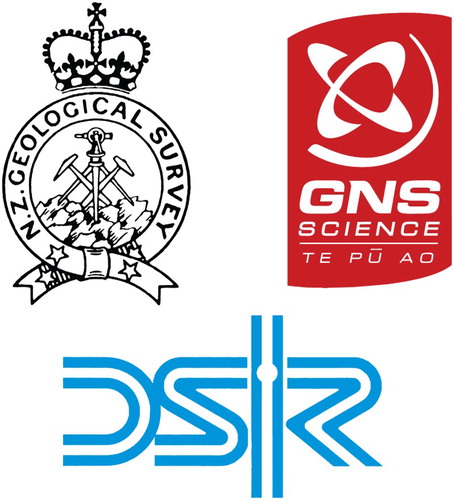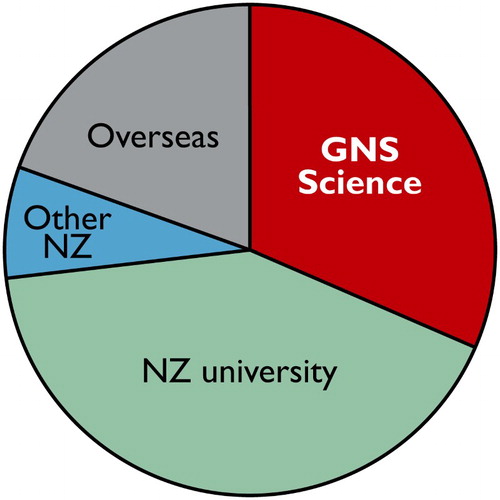The year 2015 marks the 150th anniversary of the New Zealand Geological Survey (NZGS) which was founded on 1 April 1865, becoming the first national scientific institution. The early years of NZGS are inextricably associated with James Hector, its director during the period 1865–1903. Hector and his colleagues Alexander Mackay, James Park, Frederick Hutton, Herbert Cox, John Buchanan and William Skey made full use of the Transactions and Proceedings of the New Zealand Institute (1868–1935), the New Zealand Journal of Geology and Geophysics (NZJGG) of the day, in which to publish their work.
Originally part of the Colonial Secretary's office, NZGS was moved to the Mines Department in 1887 and to the new Department of Scientific and Industrial Research (DSIR) in 1926. Geophysics Division was created as part of the DSIR in 1951, the New Zealand Oceanographic Institute in 1958 and the Institute of Nuclear Sciences (INS) in 1959. In 1992 the government disbanded the DSIR and created 10 Crown Research Institutes, including the Institute of Geological & Nuclear Sciences, which was formed from the NZGS, Geophysics Division and INS (). Today the Institute of Geological & Nuclear Sciences is best known as GNS Science. It is also my employer.
Figure 1 The insignia of the New Zealand Geological Survey, the Department of Scientific and Industrial Research and GNS Science.

Between 1865 and 1990 there were 10 Directors of the NZGS (James Hector, James Mackintosh Bell, Percy Morgan, John Henderson, Mont Ongley, Leslie Grange, Dick Willett, David Kear, Pat Suggate and Ian Speden). In 1990, Ian Speden became Director of DSIR Geology & Geophysics and, during the period 1992–2015, there have been four Chief Executive Officers of GNS Science (David Ross, Andy West, Alex Malahoff and Mike McWilliams). The NZGS had a proud record of publishing its own maps, monographs, bulletins and reports, and GNS Science continues to do this. In the same way as their university and industry colleagues, New Zealand government geologists also published their work in Transactions and Proceedings of the Royal Society of New Zealand (1936–1961), New Zealand Journal of Science and Technology (1939–1957), and continue to publish in the Journal of the Royal Society of New Zealand (1971–present) and NZJGG (1958–present).
Volume 8, issue 6 of NZJGG (December 1965) was a Special Issue devoted to the NZGS Centenary and was packed with 24 papers written by NZGS staff. It included centennial perspectives of New Zealand pre-Cretaceous geology, volcanology, Cenozoic Mollusca, economic geology, the timescale and the New Zealand landscape in art and literature. While NZJGG volume 58, issue 4 is not a Special Issue, it does, as always, contain contributions from GNS Science staff ().
Figure 2 Institutional affiliations of the first authors of the 920 research papers published in New Zealand Journal of Geology and Geophysics from 1992 to 2014. The proportions have varied little over time.

At the time of the centenary in 1965, the strengths of the NZGS and its 92 staff were paleontology, stratigraphy, volcanology, its rock and fossil collections, and geological mapping. The latter was particularly visible and acclaimed because of the then-recent completion of the first edition of 1:250 000 scale geological maps of the whole country. A lot has changed in the last 50 years. In 2015 GNS Science, now with nearly 400 employees, has large teams engaged in volcanic, seismic and landslide hazards, basin studies, marine geology, geothermal geology and materials science research, to name but a few. The paleontologists are still there and the regional geologists have recently completed QMAP, the second edition of national 1:250 000 geological maps. Nowadays we take GNS Science's digital databases, images and other products for granted; it is worth recalling that prior to 1995 virtually all files were paper-based and there was no web browser access.
This editorial acknowledges the 150th anniversary of the New Zealand Geological Survey, its sustained vitality as GNS Science and its research outputs that continue to be published in NZJGG. I thank Simon Nathan and Kari Bassett for comments on an earlier version of this editorial.
